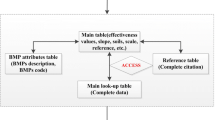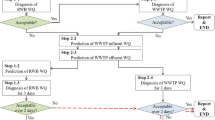Abstract
Best Management Practices (BMPs) have become the most effective way to mitigate non-point source pollution (NPS) issues. Much attention has been paid to NPS in rural areas, where agricultural activities increase nutrients, toxics, and sediments in surface water. Stormwater from urban areas is also a major contributor to NPS pollution. For watersheds bearing various soil types and land uses, a single type of BMP cannot be the panacea to all stormwater problems. To solve these problems, a Diagnostic Decision Support System (DDSS) was developed in this research. The DDSS can identify and locate the most critical NPS areas (hotspots) within a watershed in high spatial resolution. The DDSS can provide a series of spatially distributed small-scale BMPs which are effective in treating the NPS and are suitable for the physical environment. The BMPs, varying in types and locations, are recommended at HRU (Hydrologic Response Unit) level. The DDSS was tested in Watts Branch, a small urban watershed of the Anacostia River in metropolitan Washington D.C., USA. The process-based hydrologic model, Soil and Water Assessment Tool (SWAT), was used to simulate watershed responses. The simulation results were then used by the DDSS for BMP recommendation. Hotspots of different NPS were successfully located and prescribed with spatially distributed BMPs. The DDSS serves as a useful tool to better understand urban watersheds and to make proper stormwater management plans.





Similar content being viewed by others
References
Agnew LJ, Lyon S, Gérard-Marchant P, Collins VB, Lembo AJ, Steenhuis TS, Walter MT (2006) Identifying hydrologically sensitive areas: bridging the gap between science and application. J Environ Manag 78(1):63–76
Ahmadi M, Arabi M, Hoag DL, Engel BA (2013) A mixed discrete-continuous variable multiobjective genetic algorithm for targeted implementation of nonpoint source pollution control practices. Water Resour Res 49(12):8344–8356
Anta J, Peña E, Suárez J, Cagiao J (2006) A BMP selection process based on the granulometry of runoff solids in a separate urban catchment. Water SA 32(3):419–428
Ballantine D, Walling DE, Leeks GJ (2009) Mobilisation and transport of sediment-associated phosphorus by surface runoff. Water Air Soil Pollut 196(1–4):311–320
Busteed PR, Storm DE, White MJ, Stoodley SH (2009) Using SWAT to target critical source sediment and phosphorus areas in the Wister Lake Basin, USA. Am J Environ Sci 5(2):156
Carleton JN, Grizzard TJ, Godrej AN, Post HE (2001) Factors affecting the performance of stormwater treatment wetlands. Water Res 35(6):1552–1562
Chen L, Zhong Y, Wei G, Cai Y, Shen Z (2014) Development of an integrated modeling approach for identifying multilevel non-point-source priority management areas at the watershed scale. Water Resour Res 50(5):4095–4109
Chiang LC, Chaubey I, Hong NM, Lin YP, Huang T (2012) Implementation of BMP strategies for adaptation to climate change and land use change in a pasture-dominated watershed. Int J Environ Res Public Health 9(10):3654–3684
Chichakly KJ, Bowden WB, Eppstein MJ (2013) Minimization of cost, sediment load, and sensitivity to climate change in a watershed management application. Environ Model Softw 50:158–168
District Department of Environment (DDOE) (2014) Stormwater retention credit trading and internalizing the externalities of stormwater runoff in Washington, DC. AWRA 2014 annual water resources conferences. November 3–6, 2014. Tysons corner, VA
Djodjic F, Montas H, Shirmohammadi A, Bergström L, Ulén B (2002) A decision support system for phosphorus management at a watershed scale. J Environ Qual 31(3):937–945
Doherty J (2004) PEST model independent parameter estimation user manual, 5th edn Retrieved from, http://www.epa.gov/ceampubl/tools/pest
Doody DG, Archbold M, Foy RH, Flynn R (2012) Approaches to the implementation of the water framework directive: targeting mitigation measures at critical source areas of diffuse phosphorus in Irish catchments. J Environ Manag 93(1):225–234
Gburek WJ, Drungil CC, Srinivasan MS, Needelman BA, Woodward DE (2002) Variable-source-area controls on phosphorus transport: bridging the gap between research and design. J Soil Water Conserv 57(6):534–543
Geosyntec Consultants and Wright Water Engineers, Inc (2009) Urban stormwater BMP performance monitoring Retrieved from http://www.bmpdatabase.org/Docs/2009%20Stormwater%20BMP%20Monitoring%20Manual.pdf
Giri S, Nejadhashemi AP, Woznicki S, Zhang Z (2014) Analysis of best management practice effectiveness and spatiotemporal variability based on different targeting strategies. Hydrol Process 28(3):431–445
Gitau MW, Veith TL, Gburek WJ (2004) Farm-level optimization of BMP placement for cost-effective pollution reduction. Transactions of the ASAE 47(6):1923–1931
Hansen L, Hellerstein D (2006) Better targeting, better outcomes. US Department of Agriculture, Economic Research Service, Washington, DC
Heathwaite AL, Quinn PF, Hewett CJM (2005) Modelling and managing critical source areas of diffuse pollution from agricultural land using flow connectivity simulation. J Hydrol 304(1):446–461
Hogan DM, Walbridge MR (2007) Best management practices for nutrient and sediment retention in urban stormwater runoff. J Environ Qual 36:386–395
Jayakody P, Parajuli PB, Cathcart TP (2014) Impacts of climate variability on water quality with best management practices in sub-tropical climate of USA. Hydrol Process 28(23):5776–5790
Kalin L, Hantush MM (2009) An auxiliary method to reduce potential adverse impacts of projected land developments: subwatershed prioritization. Environ Manag 43(2):311–325
Lam QD, Schmalz B, Fohrer N (2011) The impact of agricultural best management practices on water quality in a north German lowland catchment. Environ Monit Assess 183(1–4):351–379
Liu R, Zhang P, Wang X, Wang J, Yu W, Shen Z (2014) Cost-effectiveness and cost-benefit analysis of BMPs in controlling agricultural nonpoint source pollution in China based on the SWAT model. Environ Monit Assess 186(12):9011–9022
Loperfido JV, Noe GB, Jarnagin ST, Hogan DM (2014) Effects of distributed and centralized stormwater best management practices and land cover on urban stream hydrology at the catchment scale. J Hydrol 519:2584–2595
Montas HJ, Shirmohammadi A, Okelo P, Sexton AM, Butler J, Chu TW (1999) Targeting agrichemical export hot spots in Maryland using Hydromod and GIS. (No. 993123, pp. 18–21). ASAE Paper No. 993123. Presented at the ASAE/CSAE-SCGR Annual Int. Meeting, Toronto, ON, Canada. July 18–21, 1999
National Oceanic and Atmospheric Administration (NOAA) (2014) National Centers for Environmental Information (NCEI) Map Viewer Retrieved from https://gis.ncdc.noaa.gov/maps/ncei/. Accessed Aug 2014
Neitsch SL, Arnold JG, Kiniry JR, Srinivasan R, Williams JR (2002) Soil and water assessment tool. User’s Manual. Version 2005. GSWRL Report 02-02, BRC Report 2-06, Temple, Texas
Niraula R, Kalin L, Wang R, Srivastava P (2012) Determining nutrient and sediment critical source areas with SWAT: effect of lumped calibration. Trans ASABE 55(1):137–147
O'Donnell TK, Baffaut C, Galat DL (2008) Predicting effects of best management practices on sediment loads to improve watershed management in the Midwest, USA. International Journal of River Basin Management 6(3):243–256
Ouyang W, Hao FH, Wang XL (2008) Regional non-point source organic pollution modeling and critical area identification for watershed best environmental management. Water Air Soil Pollut 187(1–4):251–261
Panagopoulos Y, Makropoulos C, Mimikou M (2011) Reducing surface water pollution through the assessment of the cost-effectiveness of BMPs at different spatial scales. J Environ Manag 92(10):2823–2835
Panagopoulos Y, Makropoulos C, Mimikou M (2012) Decision support for diffuse pollution management. Environ Model Softw 30:57–70
Park JY, Yu YS, Hwang SJ, Kim C, Kim SJ (2014) SWAT modeling of best management practices for Chungju dam watershed in South Korea under future climate change scenarios. Paddy Water Environ 12(1):65–75
Pionke, H. B., Gburek, W. J., Sharpley, A. N., Zollweg, J. A., Tunney, H., Carton, O. T., … & Johnston, A. E. (1997). Hydrological and chemical controls on phosphorus loss from catchments. In Phosphorus loss from soil to water. Proceedings of a workshop, Wexford, Irish Republic, 29–31 September 1995. pp. 225–242
Sadegh-Zadeh K, Montas HJ, Shirmohammadi A, Sadeghzadeh A, Gudla PR (2007) A diagnosis-prescription system for nitrogen management in environment. Journal of Environmental Science and Health Part A 42(5):557–565
Scanlon TM, Kiely G, Amboldi R (2005) Model determination of non-point source phosphorus transport pathways in a fertilized grassland catchment. Hydrol Process 19(14):2801–2814
Sharpley AN, Weld JL, Beegle DB, Kleinman PJ, Gburek WJ, Moore PA, Mullins G (2003) Development of phosphorus indices for nutrient management planning strategies in the United States. J Soil Water Conserv 58(3):137–152
Singh HV, Kalin L, Srivastava P (2010) Effect of soil data resolution on identification of critical source areas of sediment. J Hydrol Eng 16(3):253–262
Srinivasan MS, Gérard-Marchant P, Veith TL, Gburek WJ, Steenhuis TS (2005) Watershed scale modeling of critical source areas of runoff generation and phosphorus transport. J Am Water Resour Assoc 41:361–377
Srinivasan S, McDowell W (2007) Hydrological approaches to the delineation of critical-source areas of runoff. N Z J Agric Res 50(2):249–265. doi:10.1080/00288230709510293
Tripathi MP, Panda RK, Raghuwanshi NS (2005) Development of effective management plan for critical subwatersheds using SWAT model. Hydrol Process 19(3):809–826
U.S. Environmental Protection Agency (USEPA) (2003) Decision rationale district of Columbia total maximum daily loads watts branch for total suspended solids. Retrieved from, http://www.epa.gov/waters/tmdldocs/dc_tmdl-WattsBrTSS-WattsBrTSS-DR.pdf
U.S. Environmental Protection Agency (USEPA) (2013) Restoration effects stabilize watts branch and reduce sediment loading. Watts Branch. Nonpoint Source Success Stories. Retrieved from, District of Columbia http://water.epa.gov/polwaste/nps/success319/upload/dc_watts.pdf
U.S. Environmental Protection Agency (USEPA) (2002) 2000 National Water Quality Inventory. U.S. Environmental Protection Agency, Office of Water, Washington, DC. http://www.epa.gov/305b/2000report. Last updated August 18, 2003. Accessed 19 Aug 2013
United States Department of Agriculture (USDA) Natural Resources Conservation Service (NRCS) (2014) Web soil survey. Accessed in August 2014 from http://websoilsurvey.sc.egov.usda.gov/App/HomePage.htm
United States Geological Survey (USGS) (2014a) National map viewer Accessed Aug 2014Retrieved from http://viewer.nationalmap.gov/viewer/
United States Geological Survey (USGS) (2014b) USGS current water data for the nation Accessed Aug 2014Retrieved from http://waterdata.usgs.gov/nwis/rt
Walter MT, Walter MF, Brooks ES, Steenhuis TS, Boll J, Weiler K (2000) Hydrologically sensitive areas: variable source area hydrology implications for water quality risk assessment. J Soil Water Conserv 55(3):277–284
White MJ, Storm DE, Busteed PR, Stoodley SH, Phillips SJ (2009) Evaluating nonpoint source critical source area contributions at the watershed scale. J Environ Qual 38(4):1654–1663
Zhang X, Zhang M (2011) Modeling effectiveness of agricultural BMPs to reduce sediment load and organophosphate pesticides in surface runoff. Sci Total Environ 409(10):1949–1958
Acknowledgements
The authors thank the EPA for providing financial (Grant Number: R835284). This work is part of the research project “Sustainable Community Oriented Stormwater Management (S-COSM): A Sensible Strategy for the Chesapeake Bay”, which aims at efficiently improving urban stormwater conditions by increasing Best Management Practice adoption, specifically on targeted hotspots, via a Community-Based Participatory Research process. The authors would also like to thank Stephen Reiling from DC Department of the Environment for providing water quality data in the Watts Branch watershed. (http://cfpub.epa.gov/ncer_abstracts/index.cfm/fuseaction/display.abstractDetail/abstract/9911).
Author information
Authors and Affiliations
Corresponding author
Rights and permissions
About this article
Cite this article
Wang, Y., Montas, H.J., Brubaker, K.L. et al. A Diagnostic Decision Support System for BMP Selection in Small Urban Watershed. Water Resour Manage 31, 1649–1664 (2017). https://doi.org/10.1007/s11269-017-1605-x
Received:
Accepted:
Published:
Issue Date:
DOI: https://doi.org/10.1007/s11269-017-1605-x




